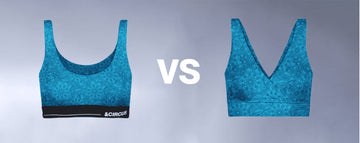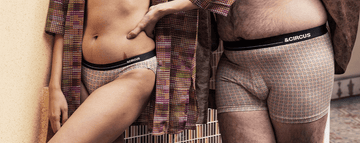In the vibrant bazaars of Mumbai, where the glow of neon signs dances on polished windows, and along the serene, palm-fringed lanes of Kochi, a subtle transformation is taking shape in the realm of apparel. Couples aren't merely exchanging promises or streaming preferences anymore they're synchronizing their closets. From harmonious silk sleepwear to aligned bamboo-infused undergarments, couple-matching ensembles are threading themselves into India's intimate apparel sector, merging affection, elegance, and a dash of heritage. Spanning regions such as Maharashtra, Karnataka, and Kerala, this movement transcends fleeting whims; it's a societal evolution redefining India's approach to romance and opulence in clothing.
Uncomfortable underwear shouldn't steal your confidence. At Andcircus, we craft ultra-soft, sustainable Lenzing Modal Micro® innerwear for every body, XS to 5XL. From briefs to bras, our custom packs fit you perfectly. Shop risk-free with our 100% satisfaction guarantee and embrace comfort that includes everyone. #LoveEveryBody. Shop Now!
The Surge of Couple-Matching Ensembles in India's Apparel Scene
The concept of couple-matching sets undergarments crafted to harmonize between partners has firmly established itself in India's metropolitan centers and is proliferating rapidly. In metropolises like Delhi, Bengaluru, and Chennai, escalating disposable earnings among millennials and Generation Z are igniting a zeal for innovation. The India lingerie market, valued at approximately USD 4.8 billion in 2023, is projected to expand at a compound annual growth rate of around 9.5% through 2032, with parallel upticks in men's coordinated apparel. This phenomenon extends beyond mere aesthetic appeal; it embodies personal articulation, bonding, and an escalating desire for tailored fashion.
In Maharashtra and Delhi, where high-end retail and online shopping dominate, sites like Flipkart and Nykaa Fashion are witnessing a surge in upscale couple ensembles. Envision satin wraps adorned with monogrammed details or eco-conscious fabric boxer combinations. Concurrently, in Tamil Nadu and Karnataka, film and popular culture propel the fad university youth in Bengaluru and Chennai are eagerly acquiring eccentric, platform-optimized sets drawn from beloved cinematic duos. The sway is palpable: an Instagram video featuring a unified lounge ensemble can trigger myriad engagements and purchases in moments.
Regional Nuances: India's States Molding the Movement
India's multifaceted nature is its asset, and the couple-matching ensemble trend mirrors this exquisitely. In Kerala and West Bengal, an expanding bourgeoisie and non-resident Indian sway are advocating for creations that equilibrate restraint with contemporary allure. Consider airy cotton pairings with understated motifs that homage ancestral traditions while captivating upwardly mobile consumers. Conversely, Telangana and Haryana are experiencing a boom in interest from secondary cities such as Hyderabad and Gurgaon, particularly amid matrimonial periods when synchronized sets emerge as favored bridal kit components or presents.
Gujarat, boasting its fabric epicenter in Surat, is embracing eco-friendliness. Shops in Ahmedabad are unveiling environmentally aware couple lines fashioned from bamboo fiber mixtures, resonating with worldwide shifts toward sustainable materials trending for couple outfits. As per the latest insights, these fabrics are ascending, with global fiber output hitting a record 124 million tonnes in 2023. Meanwhile, consumers in metropolitan Maharashtra and Delhi are increasingly opting for personalized apparel, aligning with broader market expansions. Shopping complexes in Kolkata and Kochi are leveraging celebratory times, advertising matching ensembles at Valentine's and nuptial showcases, elevating them to essentials for youthful pairs.
Global Influences Shaping Local Trends
Beyond regional dynamics, international cultural happenings are profoundly impacting couple outfit directions in India. Events like fashion weeks and festivals inspire coordinated styles, from Bollywood red-carpet looks to cross-cultural fusions. For instance, traditional Nigerian Asoebi lace ensembles, often paired with matching menswear, echo in Indian designs through vibrant prints and occasion wear, as seen in popular online inspirations. Similarly, Pinterest showcases featuring streetwear coordination denim jackets and graphic tees resonate with India's youth, blending retro vibes with modern Y2K aesthetics.
Seasonal events further amplify this. Prom and event attire, with color-matched accessories like maroon blazers and emerald gowns, translate to Indian weddings and festivities. Travel-friendly options, such as aligned beachwear and athleisure, are gaining ground in coastal states like Kerala. Forecasts indicate traditional patterns, including Ankara motifs, will penetrate broader markets, enriching India's diverse textile heritage. Google Trends data reveals peaks in searches for couple hoodies at 98 in December 2024, underscoring holiday-driven demand that Indian brands can capitalize on through customizable offerings.
Hurdles in a Varied Landscape
Nevertheless, the journey to pervasive acceptance faces obstacles. In peri-urban zones of Uttar Pradesh and segments of Haryana, societal norms can render couple-matching sets challenging to market. Traditional principles frequently favor discretion over audacious innovation, curtailing the allure of vibrant styles. Cost awareness poses another impediment although luxury items sell briskly in Mumbai, value remains paramount in West Bengal and Kerala, where patrons hesitate on discretionary expenditures.
Logistical complexities exacerbate matters. The Ministry of Textiles notes volatility in raw material prices, with cotton comprising 60% of India's textile consumption hovering at minimum support levels in 2024 due to market conditions. This instability hampers the advancement of green fabrics, potentially decelerating eco-friendly couple set proliferation. Additionally, there's a knowledge deficit: for numerous individuals, synchronized wear remains a curiosity rather than a mainstay. Labels like Clovia and Zivame, prospering in Mumbai and Bengaluru, are striving to alter this via focused initiatives, yet extensive outreach is essential to render these as commonplace as individual intimates.
Prospects in an Expanding Sector
Notwithstanding these barriers, the prospects are vast. In Delhi, Chennai, and Bengaluru, customization reigns supreme pairs seek bespoke stitching, distinctive patterns, and green materials that mirror their ethos. The matrimonial sector in Uttar Pradesh and Gujarat represents a lucrative vein, with couple sets evolving into staples for wedding acquisitions. Digital media is amplifying this surge, especially in Karnataka, Maharashtra, and Telangana, where short-form videos on Instagram and TikTok convert aligned attires into widespread phenomena.
Export avenues abound too. Fabric hubs in Tamil Nadu's Tiruppur and Gujarat's Surat are primed to ramp up output for local and Southeast Asian arenas. As worldwide happenings illuminate coordinated apparel envision Bollywood-motivated ensembles or eco-focused showcases these centers could ascend as pivotal entities. Emerging markets, including India, exhibit peak demand for such wear, propelled by a fusion of legacy and contemporaneity. Celebrity backing, like Zendaya and Tom Holland's subtle elegance, bolsters sales, though precise figures vary; in India, endorsements from stars can spike interest significantly.
Technological advancements add another dimension. The latest AI tools for personalized couple styling, such as Glance AI, recommend complementary outfits, simplifying coordination for everyday and special occasions. This integration is poised to grow, enhancing accessibility in India's tech-savvy urban pockets.
A Horizon Woven in Unity
As India's apparel domain progresses, couple-matching sets are set to transition from specialty to standard. Industry projections anticipate the lingerie segment achieving a CAGR of 11.2% from 2024 to 2030, escalating from USD 5.06 billion to USD 9.57 billion, with coordinated wear likely following suit in premium lines. The essence lies in harmonizing novelty with empathy. Enterprises must address the digital-native duo in Bengaluru while honoring the reserved preferences of rural Uttar Pradesh. It's an intricate interplay, yet one yielding tangible outcomes already.
Envision a nascent pair in Chennai perusing Nykaa for unified nightwear for their inaugural Diwali, or a Hyderabad newlywed incorporating a tailored monogrammed set into her bridal collection. These instances, modest yet profound, are what imbue this trend with vitality. As India's clothing arena flourishes buoyed by ascending revenues, online avenues, and an aptitude for merging custom with vogue couple-matching sets are interlacing more than mere threads. They're crafting a narrative of unity, one harmonized garment at a time.
Frequently Asked Questions
What challenges do couple-matching sets face in the Indian market?
The main challenges include cultural resistance in conservative areas of Uttar Pradesh and parts of Haryana where traditional values favor discretion over bold fashion choices. Price sensitivity remains a concern, especially in regions like West Bengal and Kerala where customers are cautious about discretionary spending. Additionally, raw material price volatility and limited awareness about coordinated wear pose hurdles to widespread adoption across India's diverse market landscape.
Which Indian states are leading the couple-matching apparel trend?
Metropolitan centers like Delhi, Mumbai, Bengaluru, and Chennai are at the forefront, with high-end retail and online platforms like Flipkart and Nykaa Fashion driving sales. Gujarat is embracing eco-friendly options through bamboo fiber blends, while Kerala and West Bengal focus on designs that balance tradition with contemporary appeal. Tamil Nadu and Karnataka are particularly influenced by film culture and social media trends.
What are couple-matching sets and why are they becoming popular in India?
Couple-matching sets are coordinated undergarments and apparel designed to harmonize between partners, ranging from silk sleepwear to bamboo-infused undergarments. They're gaining popularity in India due to rising disposable income among millennials and Gen Z, social media influence, and a desire for personalized fashion that expresses bonding and unity. The trend has moved beyond mere aesthetics to become a form of personal expression and relationship symbolism.
Disclaimer: The above helpful resources content contains personal opinions and experiences. The information provided is for general knowledge and does not constitute professional advice.
You may also be interested in: What Does a Matching Pair Say About Your Relationship?
Uncomfortable underwear shouldn't steal your confidence. At Andcircus, we craft ultra-soft, sustainable Lenzing Micro Modal innerwear for every body, XS to 5XL. From briefs to bras, our custom packs fit you perfectly. Shop risk-free with our 100% satisfaction guarantee and embrace comfort that includes everyone. #LoveEveryBody. Shop Now!







































